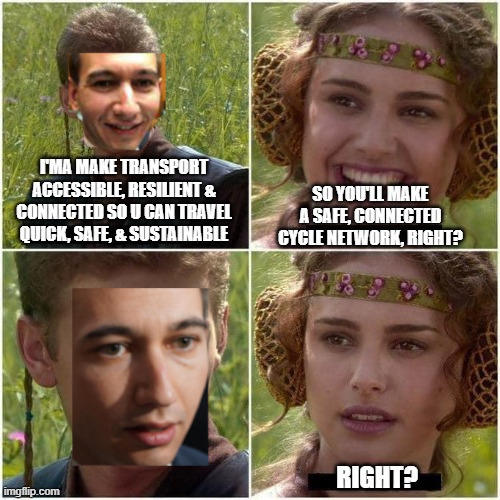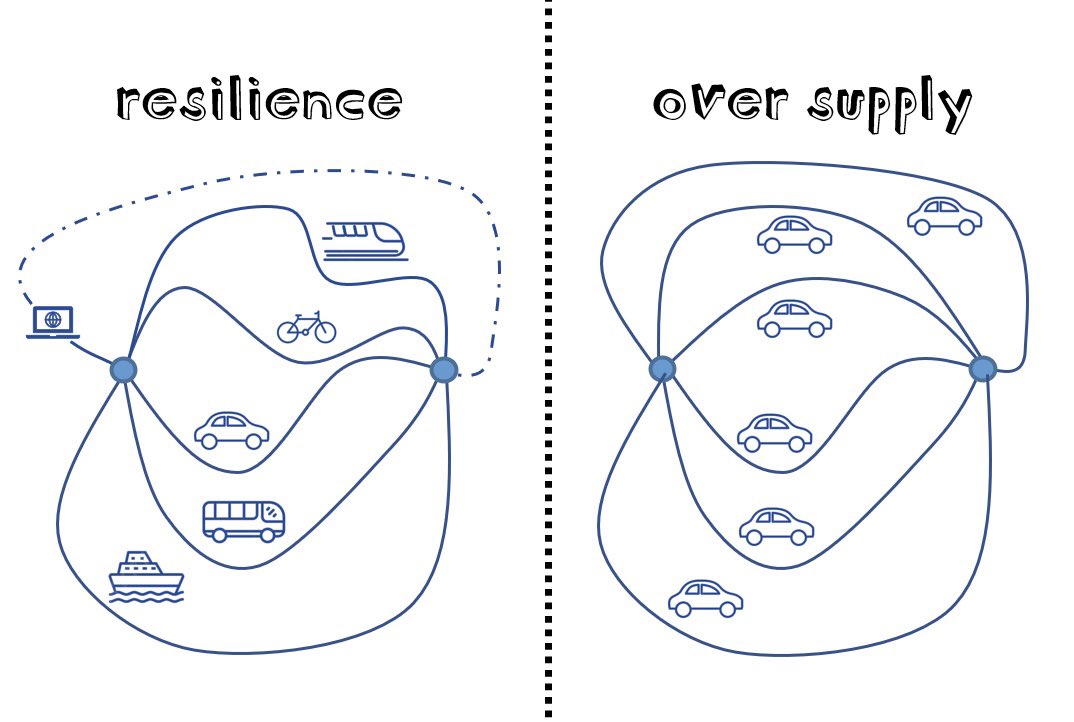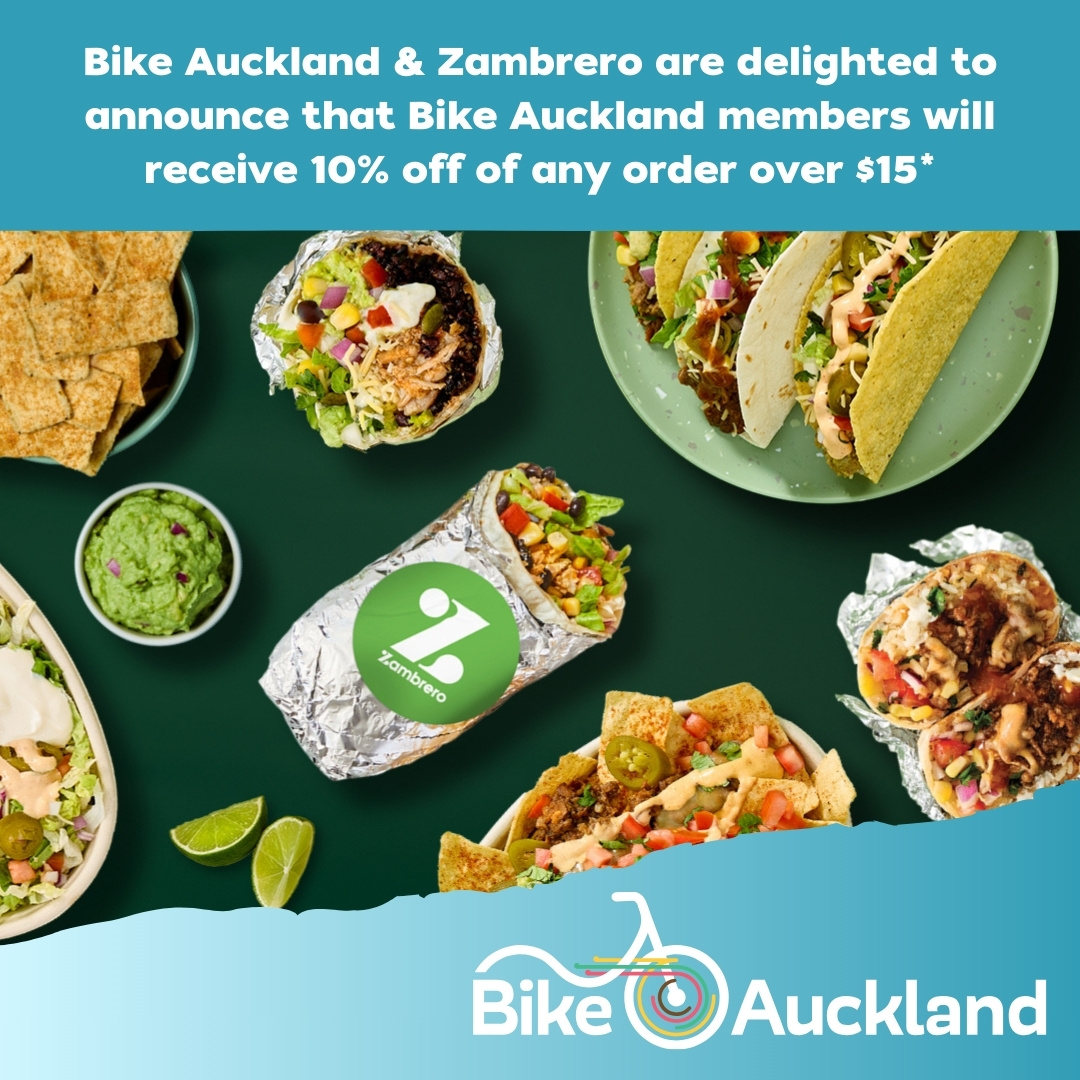MP Simeon Brown (Minister for Transport and Tāmaki Makaurau Auckland) delivered this speech to the Committee for Auckland on Friday 9 February, which included his vision for transport in Tāmaki Makaurau Auckland. He said his focus was to deliver “the infrastructure that Auckland needs, allowing Aucklanders to get to where they want to go, quickly and safely.” Throughout the speech Brown talked about “the core needs of our transport network” and that we should go “back to basics” – And what could be more basic than ensuring people can walk, bike, and wheel safely around their towns and cities?
Short-sightedly, supporting walking and cycling is not part of Brown’s transport vision, even though evidence from across the globe shows over and over that the most effective ways to achieve his targets – improve accessibility, connectivity, plan for growth, and reduce congestion – is to make it safe and convenient for people to walk, cycle, and use public transport. Chief Biking Officer Fiáin d’Leafy responds to his talking points.
MP Simeon Brown (Minister for Transport and Tāmaki Makaurau Auckland) has raised a few truths about the transport network in our region:
- It’s not accessible to get from A to B
- We have a lack of connectivity
- Our roads are congested at peak times
- We should be planning for growth
- Our transport projects tend to get started and then paused and then started and then cancelled – and this is incredibly frustrating for everyone
He’s right, you know. I was listening to his speech and found myself happily nodding along.
Simeon Brown says “My focus is on now delivering the infrastructure that Auckland needs, allowing Aucklanders to get to where they want to go, quickly and safely.”
And I nod chirpily, “oh great!” I’d love to get to where I want to go quickly and safely… on my bike. But there isn’t a safe, direct route to where I want to go if I travel by bike. Luckily for me, I’m one of the small percentage of bike riders that we call the ‘strong and fearless,’ so I ride my bike direct to where I want to go along busy, dangerous roads, and I get there quickly – much faster than using public transport, definitely faster than driving if its peak time, sometimes faster at other times too. But the majority of people⁽¹⁾ are in the ‘interested but concerned’ category. They are interested in riding a bike from A to B, but they won’t if they don’t have a safe, direct route. With the lack of alternatives, our transport network forces these people to drive for their trips, costing them more money, more time (sitting in queues of cars), and more stress.
Simeon Brown, can you deliver the safe infrastructure that Tāmaki Makaurau Auckland needs; completing our much awaited cycleway network?
Simeon Brown says “we are prioritising projects that deliver real value to commuters and businesses alike, ensuring that our cities and regions are well-connected and that our economy thrives.”
And I think, well fantastic! I want a well-connected region. A region well-connected by cycleways and safe streets so that I can commute by bike, visit businesses by bike, and do my shopping by bike…. But the current cycle network is so woefully patchy and disconnected that it barely exists, and most people can’t even safely get onto their nearest cycleway, (if they have one) let alone then be able to reach their workplace and local shops. Studies show that cycleways and safer streets typically have a positive impact, or no impact at all, on the nearby businesses⁽²⁾⁽³⁾⁽⁴⁾ . Especially because if we’re spending less on transport (bikes are cheap!) we can afford to spend more at our favourite stores.
Simeon Brown, won’t you prioritise completing the cycle network so that we have a well connected region? So that our economy can thrive?

Simeon Brown says he will be “delivering a safe network which makes efficient use of every dollar spent.”
And I think, “oh wow, exactly what I always wanted!”
One of the fastest and most affordable ways to make a safe transport network is by creating safer speed areas⁽⁵⁾ around schools, town centres, and residential streets. Combine this with raised crossings and pop up protected cycleways along arterials⁽⁶⁾⁽⁷⁾ and we’ll be able to get from A to B safer, smarter, sooner – for an amazing cost benefit ratio of at least 1:10 too⁽⁸⁾!
Won’t you change your tune, Simeon Brown, and support safer streets so that kids can safely walk, cycle, and scoot to school with their friends like they used to? So that everyone has the option to travel in a way that works for them, efficiently, affordably, sustainably?
Simeon Brown says their priorities “are investments in Auckland’s future, ensuring that our city can continue to grow and thrive sustainably.”
And I am starting to feel disillusioned, Simeon. To grow and thrive sustainably we need to have the option to get from A to B in a sustainable way. It needs to be easy for people to choose transport which is healthy for our waterways⁽⁹⁾, for our airways⁽¹⁰⁾, for our minds⁽¹¹⁾, for our bodies⁽¹²⁾⁽¹³⁾, for our climate⁽¹⁴⁾. If we don’t want our roads to be choked with congestion, if we want a future where people aren’t stuck sitting in traffic for multiple hours a day, we need people to have alternative options for how to get around⁽¹⁵⁾.
Simeon Brown, that means being able to get to where we want to go safely and conveniently by walking, by bike, as well as by public transport.
Simeon Brown says their focuses are “the core needs of our transport network.”
But he’s missing something crucial. What could be more core than walking? I see no mention at all of improving our footpaths – and they are in dire need of improvements. Our disabled communities are often forced to travel by car simply because the footpaths are so broken they are not accessible for them to use.
For many people too, cycling is their core form of transport. And you’re leaving them out. You’re leaving me out. I have joint problems and this can make it painful to walk. When my joints are bad, even walking to and from the bus stop can be too painful. Driving can be painful too. I don’t have a car anymore. It’s been much more affordable for me to not have one. Instead I get around by bike. Cycling is easy on my joints, and means I can stay active and mobile and still be involved in everyday life – this is also why physios so often recommend cycling as a form of rehabilitation. What a massive quality of life boost riding a bike is for me. But you’re telling me that my core transport mode, riding my bike, is not a core part of our transport network? There are others like me, many others, for whom a bike is mobility and freedom⁽¹⁶⁾⁽¹⁷⁾⁽¹⁸⁾. There are many who can’t or don’t drive, whether due to age, sickness, or the high cost of car ownership, and you’re saying their way of getting from A to B is not a core need of the transport network?
Simeon please, take the needs of all Aucklanders into consideration, the core transport network should be inclusive of everyone.
Simeon mentions “overall harbour resilience” and I think he may have forgotten that true resilience means a variety of options⁽¹⁹⁾, so that if one transport type fails another can be used instead. This means making sure there are safe connections for walking, cycling, and public transport, as well as driving. It means all modes – and guess which modes are currently missing on our Harbour Bridge? For true resilience we need a walking and cycling connection across the Waitematā Harbour.

Last year, 9 May 2023, during one of the extreme weather events the city was told to evacuate, the resulting traffic jam from everyone trying to leave in their cars all at once meant that no one could leave at all. The buses were stuck behind rows of cars. The trains were down due to flooding on the tracks. But you know who could get home? People riding bikes, and people riding E scooters. People gave up on waiting for buses which weren’t coming and hired themselves Limes and Beams⁽²⁰⁾ and made it home in no time at all. Guess who didn’t have that option? Anyone trying to get from the CBD back to the North Shore. Liberate the Lane for greater transport resilience.
Simeon, a truly resilient transport network would give people the option to get around by all modes. When people have options some of them will switch out of their cars – less people using cars means less congestion – and means more resilience during disasters like that one.
“By focusing on these critical areas, we are laying the groundwork for a transport system that meets the needs of Aucklanders today, while also anticipating the demands of tomorrow.”
Your “critical areas” leave out roughly a third of Aucklanders. 31% of over-16’s don’t have a full drivers licence⁽²¹⁾. And there are more who have a licence but still don’t drive. There are others who currently feel forced to drive because the transport network doesn’t give them safe, convenient routes to get to where they want to go by walking, cycling, and public transport. The cost of car ownership is high. A 2015 study estimated that the average New Zealander who commutes by car is losing $11,852.98 per year for their car ownership and running costs, while people who don’t own a car and travel by public transport are saving $9065.78 per year⁽²²⁾. More recent estimates are that commuting into Tāmaki Makaurau CBD costs roughly 6 times more than taking public transport the same distance, when including parking and vehicle fixed costs⁽²³⁾. Cycling for transport is even more affordable – and much more reliable, as we don’t get stuck in queues of motor traffic. A lack of investment in safe, convenient cycleways and public transport leaves people no option except to drive for their trips and forces them to spend more money during a cost of living crisis.
Simeon, are we invisible to you? If we don’t drive a car, if we don’t want to drive a car, do our needs not count to you?
Let’s revisit those truths
1. It’s not accessible to get from A to B in our region… for people walking, cycling, wheeling and using public transport
2. We have a lack of connectivity… for people walking, cycling, wheeling and using public transport
3. Our roads are congested at peak times…. for people driving cars, or in buses
4. We should be planning for growth… and that means empowering people to choose more efficient transport modes such as walking, cycling, and public transport, or our city will become even more congested
5. Our transport projects tend to get started and then paused and then started and then cancelled – and this is incredibly frustrating for everyone … This happens frustratingly frequently for walking and cycling projects. The recent cancellation of the Regional Fuel Tax (without having another revenue stream to take its place) means there will be even more cancellation and delay for a whole range of projects which would have delivered a more connected, accessible, flourishing, and growth-oriented region.
7 out of 10 urban New Zealanders are supportive of cycling in their communities and a majority are supportive of investment in cycle infrastructure⁽²⁴⁾. Everyday Aucklanders, like me, just want an accessible and reliable transport network so we can get to where we want to go safely, conveniently. To realise that dream, our transport network needs to provide more safety and convenience for walking, cycling and wheeling, as well as public transport, from A to B.
Why is this government so averse to investing in the future that communities want?
To achieve the flourishing Aotearoa NZ we all envision, MP Simeon Brown needs to include walking and cycling, alongside public transport and driving, into the transport strategy so that all modes of transport – and all people – are provided for.
Cheers mate,
Fiáin d’Leafy.
References:
- Understanding the 4 types of cyclists or The Aotearoa context: Understanding attitudes and perceptions of cycling and walking
- Why bike lanes are actually a boon for business
- Bike lanes provide positive economic impact
- The Complete Business Case for Converting Street Parking Into Bike Lanes
- Safe speeds, the reasons
- The Societal Costs and Benefits of Commuter Bicycling: Simulating the Effects of Specific Policies Using System Dynamics Modeling
- Provisional COVID-19 infrastructure induces large, rapid increases in cycling
- A Cost Benefit Analysis of an Active Travel Intervention with Health and Carbon Emission Reduction Benefits
- Running off the road
- Moving urban trips from cars to bicycles: impact on health and emissions
- The relationship between transport and mental health in Aotearoa
- Association between active commuting and incident cardiovascular disease, cancer, and mortality: prospective cohort study
- The weight of Place; built environment correlates with obesity and diabetes
- The climate change mitigation effects of daily active travel in cities
- Disappearing traffic? The story so far
- I use a wheelchair and I want more bike lanes
- A rolling walking stick; why do so many disabled people cycle in Cambridge
- E-bikes towards inclusive mobility
- Resilience Point of View Series; Transport
- Stranded mates ride scooters from CBD to west Auckland as floods gridlock city
- Rates of Driver licence holding in Aotearoa NZ, by territorial authority
- The cost of commuting: an analysis of potential commuter savings.
- Sustainable urban mobility benchmarking report
- Understanding attitudes and perceptions of cycling and walking




